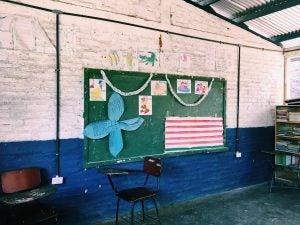This spring break—with the aid of a BLI small grant—I travelled to Nicaragua to help
install electricity in a school building. I went with the Nicaragua Mission Team from my local church. The trip was intergenerational: five of us were in our twenties and thirties, and the other five were in their 60s and 70s and had been to Nicaragua several times before. The school we worked with was located in the small community of Quebrada Honda in Pantasma. The trip was challenging, meaningful, and perspective-giving. After arriving at the airport and spending a night in Managua, our team drove for four hours, zig-zagging through beautiful mountains to reach the small town in Pantasma where we would sleep every night. The conditions were far from luxurious—we definitely left our “creature comforts” at home. We all slept on mats on a floor and our shower—which was in a separate building—consisted of cold water and a dirt floor. We had to be careful to not drink the tap water, as it contained bacteria that we were not accustomed to.
Monday through Thursday, we woke up at 7 AM and—after driving about 30 minutes to get to Quebrada Honda—worked for several hours installing electricity in the school. The community had asked us to do the electrical work in three out of its four classrooms, and—after initial prayers and dances given by the community—we began measuring conduit, cutting wires, and drilling holes in the walls and ceilings. Though we had had two orientation sessions before leaving in Ann Arbor, I was mostly learning how to do the work through doing it. At the end of the day Thursday, we tested our work with a rented generator and—after some trouble- shooting—confirmed that the lights and outlets were functional. Now the community must wait for the government to run electricity to their community so that they can use what we installed.
Throughout the trip, our team focused on the concept of serving through relationship. Through morning devotions and evening reflections, we continuously asked ourselves, “What does serving through relationship look and feel like?” We wanted to prioritize the community’s needs, hopes, and dreams. In this way, we strove to serve through partnership instead of imposing our own goals and culture. We recognized that the community would benefit from the electricity—not us—and wanted the community to feel a sense of ownership of the project. This translated into us sometimes stepping aside to let community members participate in the drilling, taping, and measuring. The community members were eager to help, and at one point I was teaching children how to twist and tape wires to assemble a functional electrical outlet.
I am taking Spanish for my language requirement and enjoyed having an opportunity to practice speaking the language. I spent much time with the children in the community, who followed me around and constantly asked if I could play ball or frisbee with them. The children were gracious and patient with me as I sometimes struggled to construct sentences or pronounce their names incorrectly. Though I could not understand all of what they said, I understood much of it. Communicating with these young people from a different culture brought me much joy.
The intergenerational aspect of the trip was particularly meaningful to me. As a college student, I spend most of my time interacting with people my age. This trip was a rare opportunity for me to befriend and spend quality time learning from another generation. Each evening, we reflected as a team. We asked ourselves, “What moments from today surprised you or brought you joy?” and, “What moments challenged you?” These questions led to honest conversations about our goals and experiences and enabled us to encourage and support each other through challenges. We realized that serving through a model of relationship also meant supporting each other as team members.
At the end of the trip, a nearby community invited us to visit and requested that we build two new classrooms for them. This request made us think: Should we grant this request for this new community, even though we are not as comfortable building classrooms as we are installing electricity? Or should we continue to build a relationship with the community in Quebrada Honda, a community we already know and love?
These are ultimately questions that the Nicaragua Mission Team will have to wrestle with, and I hope to be a part of the discussion.
By Miriam Ernest






